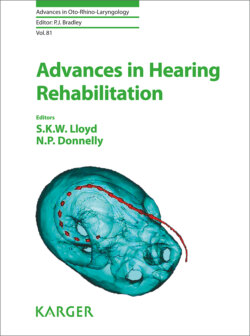Читать книгу Advances in Hearing Rehabilitation - Группа авторов - Страница 40
На сайте Литреса книга снята с продажи.
Other Issues
ОглавлениеAdapting to Static Forces: Ideally, the prosthesis would be able to adapt to changing middle ear pressures. If the TM is lateralized or medialized, the prosthesis would change to accommodate this, otherwise it might displace. Although several self-expanding prostheses have been proposed, there are currently no prostheses in common use that have been proven to accomplish this.
Scarring and Coatings on Prostheses: Whilst many types of coatings have been marketed on ventilation tubes to act as antimicrobial or anti-inflammatory measures, these have not been adopted for middle ear prostheses. Indeed, scarring is one of the most detrimental factors in reducing prosthesis vibration. We found that cementing a prosthesis to the promontory reduced stapes vibrations by 10–20 dB [29] and, in other unpublished experiments, gluing it to the annulus or steri-stripping the TM covering the prosthesis to the annulus reduced stapes vibrations by 7–10 dB.
